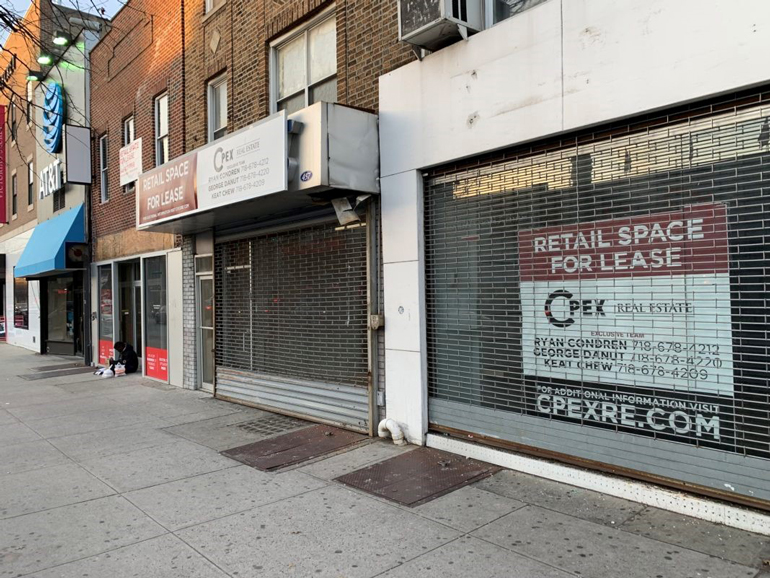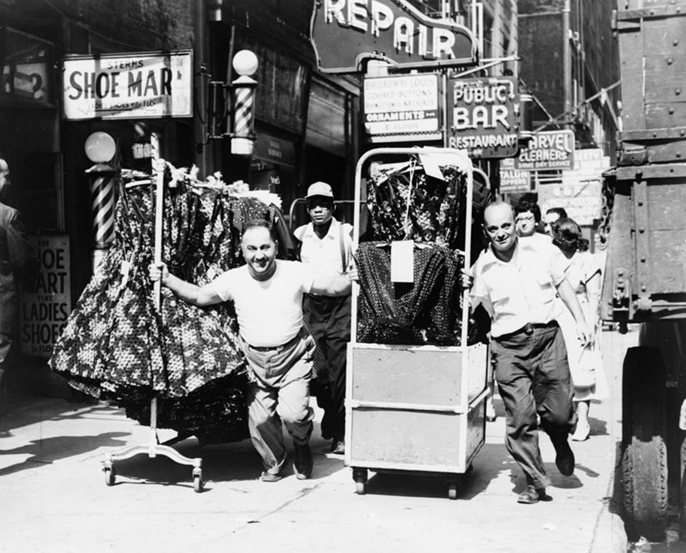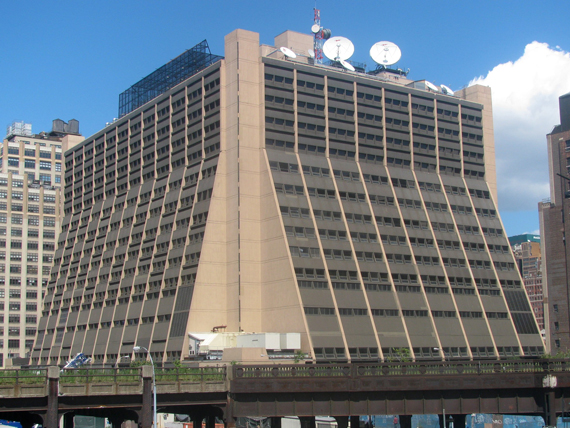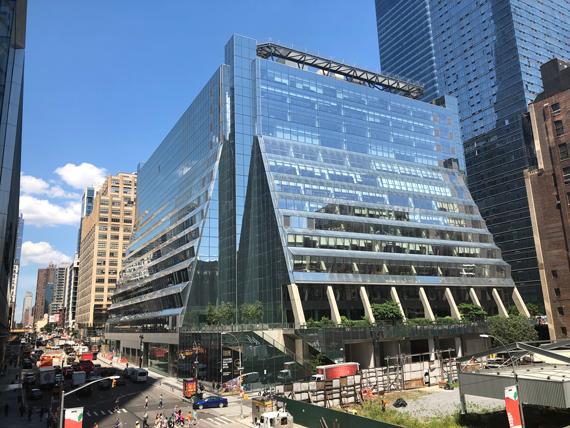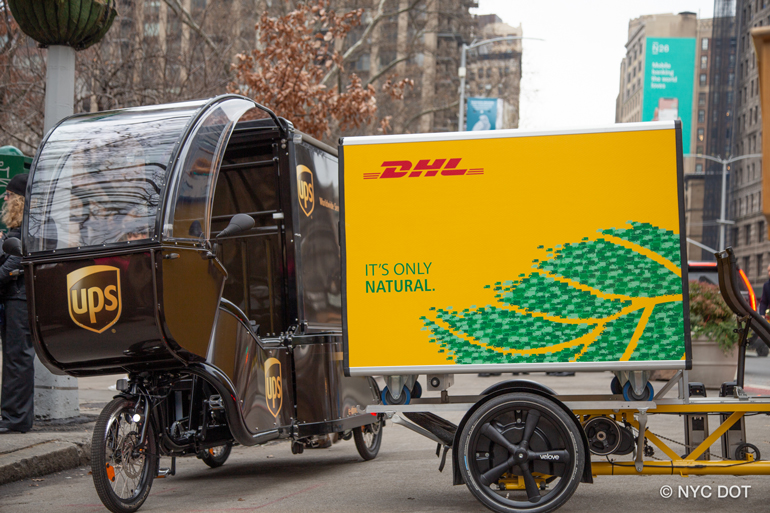
We are celebrating 15 years — and counting — of stories that are deeply researched and deeply felt, that build a historical record of what the city has been.
We are celebrating 15 years — and counting — of stories that are deeply researched and deeply felt, that build a historical record of what the city has been.
Crowded curbsides. Blocked bike lanes. A deluge of double-parking. The on-demand economy demands a lot from New York’s streets. An average day sees about 1.1 million shipments roll out across the city — a three-fold increase from 2009, at the dawn of same-day delivery. Congestion isn’t the only byproduct of instant gratification. As the carbon footprint of e-commerce grows, and vacant storefronts proliferate, the environmental and social costs to this profound shift in consumption are becoming clearer by the day. But the so-called “last mile” is also a place where people live their lives. How might logistics better integrate with the city’s sidewalk ballet?
As it turns out, this is not an entirely new question. The current glut of e-commerce traffic echoes an earlier period when the city’s manufacturers spilled chaotically onto the streets and sidewalks of the city. As companies dream up solutions for orchestrating the complex space-time of deliveries — from apps to autonomous pods — cities stand at a crossroads between the core values of place and the uncharted promises of technology. Below, David Vega-Barachowitz and Adam Lubinsky of WXY explore how planning and policy measures can better inform this conversation and help cities re-imagine urban freight. Surveying the street-level snarl of trucks, carts, dollies and people, they consider how we might reuse and coordinate the spaces we already have to meet shared challenges in the new logistics city.
One morning in December 2019, the curb outside our office’s building suddenly transformed into a miniature city of cardboard boxes. Two FedEx box trucks fed the growing skyline, assembled and then hastily disassembled as an army of hand truck operators arrived to cart the temporary metropolis away. The rapid creation and destruction of cardboard cities has become a routine part of urban life, as companies increasingly turn public curbside space into mini-distribution hubs to feed our limitless appetite for on-demand delivery. The revolution in online shopping and on-demand delivery has quickly emerged as a destabilizing threat to cities and neighborhoods, affecting brick-and-mortar retailers, users of city streets, residents of areas where distribution hubs are springing forth, and the global environment.
This new paradigm of consumption is also increasingly becoming second nature — a service that people rely on to provide unmatched convenience and an ability to easily compare the cost of goods. At its core, however, the advent of on-demand delivery is a multipronged problem that threatens to negate the “placeness” of cities. It focuses on overcoming “space” and “time,” rather than reinforcing the unique characteristics of urban neighborhoods. This presents several pressing challenges. City streets have become de facto delivery depots, cluttering curbsides, compromising bike lanes, and creating an unrelenting pattern of double-parking.
For brick-and-mortar retailers today, the implications of online deliveries are tangible and terrifying. Experts anticipate that e-commerce will represent 25 percent of all retail sales by 2030. Macy’s, an emblem of the department store age, recently announced that it will close 125 stores over the next three years. Dead suburban malls, the old adversary of declining downtowns, have been transformed into eerie ruins. Even as superstar cities have boomed over the past decade, cultural and consumer trends continue to point away from traditional retail and towards instant gratification. When all the malls and retail shops have left, what will take their place?
Meanwhile, increased truck trips have resulted in rising carbon emissions. As e-commerce expands, so too does the average dwell time for delivery vehicles. While some have claimed that deliveries reduce the number of car trips to shopping locations, according to Miguel Jaller, co-director of the Sustainable Freight Research Center at UC Davis, “climate benefits to e-commerce . . . disappear as delivery gets faster and faster.” This growth in freight trucking, moreover, is compounded by large warehouse spaces that require heating and power: 255 million square feet of warehouse space is currently under construction across the US. What role can design and policy play in confronting the growth of e-commerce and its increasing impact on the built environment of cities?
Street congestion caused by deliveries is nothing new in New York City. During the mid-20th century, the Garment District embodied the intractable tensions surrounding the movement of goods in a dense city largely built out before the introduction of off-street loading regulations in the 1940s and 1950s. The Garment District lacked modern facilities, and its streets ensnarled traffic and pedestrians alike. The neighborhood lacked any hint of the logic of modern manufacturing centers then sprouting at the urban fringe (or their amenities, loading docks, and efficiencies). Its sidewalks were crowded by trucks rushing apparel across sidewalks through traffic and businesses, creating chaos for pedestrians. The City began testing remedies to the Garment District’s chaotic street traffic as early as the 1930s. In a 1976 report, the New York City Transportation Administration made a variety of recommendations to modernize curbside operations and institute more predictable street management, a goal that remained elusive until the industry’s decline in the 1980s.
Just as the Garment District’s congestion spurred a string of studies on apparel industry logistics in the middle of the last century, both governments and private companies have begun to experiment with a variety of solutions to confront today’s e-commerce menace. Recognizing the rise in residential e-commerce deliveries, along with a plague of double parking and a need for dedicated pick-up/drop-off zones, New York City launched a demonstration program in 2019 to create neighborhood loading zones just off commercial corridors. In an experiment which echoed efforts to curtail Garment District traffic during the 1960s, the City also briefly tested a curbside parking and loading ban in Midtown to ease the flow of traffic during rush hour.
Amazon, UPS, and other companies have begun aggressively setting up locker boxes in cities across the country to reduce the complexity of delivering to multiple residential addresses, especially during work hours. Locker boxes have popped up in subway stations, convenience stores, apartment buildings, and even gas stations. In Seattle, carriers using lockers saw a 78 percent reduction in delivery times compared to traditional door-to-door delivery.[1] Even as e-commerce erodes their bottom line, traditional retailers like Walgreens and Staples have recognized the trend as an opportunity to get customers in the door.
While locker boxes may be effective in the near term, many technology companies are betting on the future of logistics looking a lot different than box trucks at the curb. In 2019, autonomous vehicle startup Udelv began a series of last-mile delivery pilots in Houston, Phoenix, and the Bay Area, essentially functioning as an autonomous mobile delivery locker. In Washington DC, the District Department of Transportation and startup Curb Flow are partnering on a curbside reservation system to increase turnover in commercial loading areas. Drone delivery startups like Hubvery and Flirtey have attracted millions of dollars in startup capital, some promising to shift the logistical clutter of delivery into airspace, evoking images of 1950s helipads and passenger zeppelins in the sky. In comically dystopian fashion, Pizza Hut and Domino’s waded into the freight revolution, announcing competing autonomous delivery bots meant to reduce the friction of interacting with the pizza delivery man, while keeping your pizza fresh. In a proposal that brings together and epitomizes these trends, Toyota envisioned a future characterized by multifunctional e-Palette pods floating through a white-washed sim-city, effortlessly mutating from microbus to lunch delivery pod to rideshare vehicle and package distributor. Handcarts and employees are notably absent from these visions, replaced instead by even smaller autonomous micropods, that spew from their larger containers in a scene reminiscent of Pieter Bruegel’s Big Fish Eat Little Fish.
Modern urban delivery is rooted largely in supply chain and logistics approaches that emerged when freight rail gave way to long-haul trucking during the 1940s and 1950s. In this emerging paradigm, the city was a dinosaur: a costly and complex last mile of the carrier’s journey. As manufacturing firms fled cities to reduce those costs, governments responded by inventing spatial and regulatory systems to accommodate modern freight. In 1940, New York City began requiring that new buildings include loading docks based on commercial and manufacturing building square footage. These loading regulations have changed little since 1952, and are generally based on a building’s overall size, use, and zoning district. Before its glossy reincarnation, the stocky 5 Manhattan West was known as the Westyard Distribution Center (and before that, Midtown Mart), a city-backed project that sought to keep commercial and manufacturing tenants from moving to the suburbs. The ziggurat-shaped building, which opened in 1970 and was designed by Davis, Brody & Associates, had immense manufacturing floorplates ranging from 90,000 to 120,000 square feet and included over 60 loading docks.
While New York City has historically focused on changes to loading regulations and traffic on-street, there are a host of off-street regulations and strategies that it could pilot in the future. One of the most powerful of these would be embracing a more multifunctional approach to loading docks themselves. While many loading docks are well used, others, especially in older buildings and streets that have access challenges, are occupied by parked cars, trash, or storage. The city could allow buildings to convert underused loading docks into facilities that provide support to freight carriers, such as pickup stores, locker boxes, or even consolidation points for freight bikes. Where existing loading docks are ill-suited to meet today’s freight demands, a new policy could allow for the reclamation of ground floor space in exchange for a contribution to a districtwide freight management entity or enrollment in the city’s off-hours deliveries program.
It is essential that transportation planners start thinking beyond managing the impacts of freight at the building level and begin approaching it at a district level. New York City’s zoning code currently allows for two adjacent buildings to share a loading dock. Much as it does with parking and affordable housing, the code could be altered to permit buildings to send their loading infrastructure to a shared off-street facility within a prescribed area or to pool their docks with other buildings in the same block (or collection of blocks) during development. More innovative and flexible approaches to loading regulations in zoning could help businesses and residents better manage resource flows, both on-street and off-street. (WXY has explored such approaches in our 2017 report for the New York State Energy Research and Development Authority on emerging freight and delivery challenges in New York City.)
Some governments have tried to solve the small shipment problem by encouraging or incentivizing consolidation by smaller businesses, whose cumulative impact on traffic and sidewalks is most disruptive and unpredictable. In Japan, the UK, and the Netherlands — countries with large, robust, and well-resourced local, provincial, and national governments — public agencies have tried to institute large-scale urban consolidation centers that require large trucks to unload and transfer to smaller vehicles. Even there, these experiments have been unwieldly. Urban consolidation centers are extremely challenging to maintain, and unpopular with carriers, who find them costlier, less flexible, and slower.
In the US, many carriers consolidate privately instead. Near the last mile of a delivery, some carriers use box trucks as micro-consolidation hubs. Networks of trucks drop packages off at a single hub, which serves as a distribution point for handcart deliveries within a block or two radius. This practice is neither uncommon nor new. Many garment firms in the 1960s simply used trucks parked curbside as small consolidation centers, with a single truck handling multiple deliveries and pickups from others. Some trucking firms, however, rented small storefronts known as so-called “trucking stores” to consolidate shipments and temporarily store merchandise. The modern manifestation of that trend, Amazon’s package pickup storefronts, is still a pilot, but could be more widely deployed, especially as retail vacancies mount.
Where off-street loading docks are no longer proving useful, they could be converted into experience-oriented retail, such as bars and restaurants. In Lower Manhattan, many large office buildings built in the 1950s and 1960s have loading docks on side streets that are today incapable of accommodating large trucks, creating dark and inactive alleys. In some instances, old manufacturing buildings undergoing conversion have sought relief from the city’s cumbersome loading regulations. At WeWork’s DUMBO campus, formerly the long-time headquarters of the Jehovah’s Witnesses, a loading bay was converted into a beer hall. As developers continue moving into former manufacturing areas, demands for exemption from old regulations have accelerated, but this pattern of reuse and recycling of old manufacturing infrastructure has a long history. Loading bays in Tribeca and Soho were converted to the front doors of restaurants and boutiques starting in the 1970s. In Melbourne, Washington DC, and Chicago, alleys and laneways that once provided crucial servicing for buildings have been transformed into active public spaces.
While the rise in on-demand deliveries has clear implications for the public and private spaces of the city, there are also considerable environmental issues to contend with. As trucks proliferate, the decarbonization of freight has become a pressing need, especially in neighborhoods where distribution and trucking uses are concentrated. To combat rising carbon emissions, the city could create policy incentives for clean trucks, such as free “green” loading zones, loading docks equipped with EV charging infrastructure, the use of high-occupancy vehicle lanes, and exemption from congestion charging.
Another solution could be to shift freight from four wheels to two. In December 2019, New York City announced a pilot with DHL, UPS, and Amazon to test electric cargo bikes in Lower Manhattan. Implementation relied less on stick than carrot, allowing the new electric bikes to park for free in commercial loading zones typically reserved for trucks and vans. Cargo bikes, which are widely used in dense, residential areas of European cities, are also suited to many parts of New York, where modern trucks face circulation and turning challenges. In Seattle, the city allowed UPS to turn several downtown parking spaces into an area for loading and unloading cargo bikes — a kind of on-street consolidation hub. It’s not difficult to imagine the City of New York implementing on-street regulations that would encourage truck-to-freight bike transfers in Lower Manhattan, or working with Business Improvement Districts across the city to implement similar pilots.
As e-commerce continues to grow, city logistics policies must shift from managing space to managing place. Historically, transportation planners have viewed deliveries as a nuisance that can put out of sight and out of mind (either underground, above ground, or off-street). More recent solutions like off-peak deliveries, signed regulations, and app-based curbside management have tried to manage space by better allocating time. In 2017, the City’s Transportation Department embarked on a multiyear freight master plan to rethink the infrastructure around deliveries; a year later, the Economic Development Corporation released a plan of its own. The most significant changes to policy would need to come through more robust and multifaceted zoning changes that reshape our understanding of the retail, office, and manufacturing landscapes, while allowing for more innovative approaches at the building and district scale.
While spatial and temporal solutions will be critical in the future of freight, the larger implications for place need further contemplation. What role will fulfillment and distribution centers play in the future of cities and neighborhoods? How can existing underutilized infrastructure become more multifunctional? What regulations can ensure that rising deliveries don’t also mean rising asthma rates and environmental injustices? It remains unclear how much of an impact e-commerce will have on cities and to what extent consumers will tolerate the loss of place for gains in convenience and price. Yet by creating and embracing policies that shape and enhance the places and neighborhoods that e-commerce affects, cities can creatively integrate internet retail into the physical space of the city.
Anne Goodchild, Haena Kim, and Barbara Ivanov. Common Carrier Locker System Pilot Test in the Seattle Municipal Tower: Final Project Report (Seattle, WA: Pacific Northwest Transportation Consortium, 2019).
The views expressed here are those of the authors only and do not reflect the position of The Architectural League of New York.
